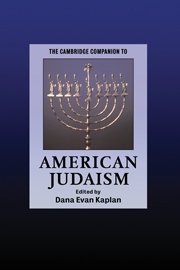Book contents
- Frontmatter
- Introduction
- Part I Historical overviews
- Part II Themes and concepts
- Section 1 Religious Culture and Institutional Practice
- Section 2 Identity and Community
- Section 3 Living in America
- 15 The American Jewish urban experience
- 16 "Sacred Survivial”revisited: American Jewish civil religion in the new millennium
- 17 Judaism and democracy in America
- 18 The economics of American Judaism
- 19 American Judaism and interfaith dialogue
- Section 4 Jewish Art in America
- Section 5 The Future
- Afterword
- Further reading
- Index
- Series list
15 - The American Jewish urban experience
from Section 3 - Living in America
Published online by Cambridge University Press: 28 May 2006
- Frontmatter
- Introduction
- Part I Historical overviews
- Part II Themes and concepts
- Section 1 Religious Culture and Institutional Practice
- Section 2 Identity and Community
- Section 3 Living in America
- 15 The American Jewish urban experience
- 16 "Sacred Survivial”revisited: American Jewish civil religion in the new millennium
- 17 Judaism and democracy in America
- 18 The economics of American Judaism
- 19 American Judaism and interfaith dialogue
- Section 4 Jewish Art in America
- Section 5 The Future
- Afterword
- Further reading
- Index
- Series list
Summary
To evoke the American Jewish urban experience may seem like an exercise in nostalgia, indulging in a history whose bearing on the lives of American Jews today is debatable. What, after all, is urban about American Jews today? Presently, almost all Jews live in cities, towns, suburbs, and metropolitan areas that are officially considered “urban” by U.S. census standards. However, nowadays, urban holds a rather different meaning from that used in the census; it refers to the central city of a metropolitan area. More specifically, it refers to the dense and historic inner city, which has been steadily eclipsed demographically by the growth of suburbs and exurbs and by migration to developing new cities in the South, Southwest, and West. In fact, urban today has an even narrower meaning and often evokes the city of minorities, the Hispanics and African Americans, who tend to make up the greater part of the central city population. This kind of urban city brings to mind the social problems, regardless of their origins, currently associated with inner-city minorities. With this kind of city, American Jews today have little direct experience.
THE AMERICAN JEWISH URBAN EXPERIENCE
At the close of World War II, two great migrations began emptying the inner cities of Jews, leaving these areas for the most part without a substantial Jewish population. These two migratory waves resulted in a radical redistribution of the Jewish population of the United States in the thirty years after World War II. The first migration was to the suburbs; the second was to cities in California and Florida. The demographic change can be traced in the annual Jewish population statistics of the American Jewish Year Book. The data show a steady rise of the cities of the South and Southwest to the point where the second and third largest Jewish population concentrations today are no longer Chicago and Philadelphia, but Los Angeles and Miami.
- Type
- Chapter
- Information
- The Cambridge Companion to American Judaism , pp. 271 - 282Publisher: Cambridge University PressPrint publication year: 2005

